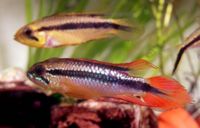Agassizi's Dwarf Cichlid (Apistogramma agassizii)
From The Aquarium Wiki
(Redirected from Agassiz's Dwarf Cichlid)
Agassizi's Dwarf Cichlid
Apistogramma agassizii
76 Litres (20 US G.)
5.1-8.9cm (2-3.5 ")
Freshwater
6.0 - 7.0
23.9-26.7°C (75 -80 °F)
6-10 °d
1:2 M:F
5-6 years
Family
Cichlidae
This animal is available captive bred
Contents
Additional names
- Agassizi's Dwarf Cichlid
Additional scientific names
- Apistogramma agassizi, Apistogramma parva, Geophagus agassizii
Origin[edit]
- Leaf litter of the Rio Ucayali and lower Rio Negro.
Sexing[edit]
- Males are more colourful, have extended finnage and are usually larger than females.
Breeding[edit]
- Requires soft water to breed. Like most Apistos, they are harem breeders; one male spreads his time between multiple females. This fish is a cave breeder; the female may lay from 50-100 eggs on the roof of a cave, which the male then fertilizes. Female will guard eggs and subsequent fry, while male will defend entire territory.
Tank compatibility[edit]
- Considered to be peaceful and a good community fish. Males are territorial, and if more then one male is kept in the same tank, much space and cover must be provided to allow for the creation of each male's territory.
Diet[edit]
- Good quality flake food, but should be supplemented with vegetables, frozen, freeze dried and/or live food. Mosquito larva, tubifex worms, blood worms, water fleas, brine shrimp and Cyclops are all excellent additions to their diet.
Feeding regime[edit]
- Feed once or twice a day.
Environment specifics[edit]
- Provide with hiding places/caves made from driftwood and unglazed ceramic pots. In order to give them the best quality of life and enjoy the fullest display of natural behaviour, a well-planted tank should be provided. Sensitive to water quality issues, regular water changes are a must. Like all Apistos, they are sensitive to toxins, medications and low oxygen levels as.
Behaviour[edit]
- A territorial but generally not overly aggressive Cichlid. Males will be territorial towards other males so ideally only one pair should be kept per tank.
Identification[edit]
- An attractive dwarf Cichlid with a bold dark lateral line from the nose and through the caudal fin. The body is pale with hints of yellow and orange and some blue iridescence, the fins are a dark vivid red-orange. There are some regional colour variations.
Photos[edit]
Videos[edit]
External links[edit]
- Fishbase (Mirrors:
 )
)


